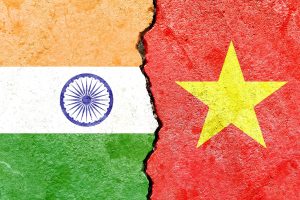Vietnam’s Prime Minister Pham Minh Chinh last night arrived in India on a three-day state visit at the invitation of Prime Minister Narendra Modi, with the aim of consolidating the recent advances in economic and security relations between the two nations.
According to a report by the Communist Party of Vietnam mouthpiece Nhan Dan, the Vietnamese leader is scheduled to hold talks and meetings with Modi, President Droupadi Murmu, and the speakers of both houses of the Indian parliament.
The visit is “expected to strengthen bilateral cooperation in traditional fields and expand to potential fields such as electronics, telecommunications, pharmaceuticals, renewable energy, green economy, digital economy, artificial intelligence, semi-conductor, new materials and essential minerals,” the report stated.
It will also contribute “to enhancing political trust and deepening the multi-faceted cooperation between the two countries” and give them an “to share views on security and strategic issues in the region and the world and reiterate their mutual support in multilateral forums of common interest.”
Chinh’s visit is the first by a Vietnamese or Indian prime minister to the other country since the two nations established their comprehensive strategic partnership in September 2016, when India became the third nation to attain this status after China (2008) and Russia (2012). These three nations have since been joined at the top tier of Vietnam’s diplomatic hierarchy by South Korea, the United States, Japan, and Australia. Together, this roster of key partners, which could soon be joined by Indonesia and Singapore, encapsulates Vietnam’s flexible and omnidirectional foreign policy doctrine.
India forms an important, though often overlooked, part of this strategy. For India, too, Vietnam occupies a key position in both its Act East Policy, which seeks to advance relations with the nations of Southeast Asia, and its Indo-Pacific vision. This, as Amb. Saurabh Kumar, Secretary (East) of the Indian Ministry of External Affairs put it in 2022, “envisages a free, open, inclusive, peaceful and prosperous Indo-Pacific, built on a rules-based order and with sustainable and transparent infrastructure investments.”
Since the establishment of the comprehensive strategic partnership in 2016, trade between the two sides has grown by around two-and-a-half times, reaching $14.8 billion in 2023. As with India’s relations with Southeast Asia in general, economic cooperation is modest compared to its potential, making it a logical focus of future cooperation. As a point of comparison, Vietnam’s bilateral trade with China totaled $171.2 billion in 2023; its trade with the United States came to around $125 billion.
The potential has been realized to a greater extent in bilateral defense cooperation, which has been motivated by an overlapping concern about China’s growing maritime power and assertiveness. In June 2022, Indian Defense Minister Rajnath Singh and his Vietnamese counterpart Gen. Phan Van Giang signed a “Joint Vision Statement on India-Vietnam Defense Partnership Towards 2030,” which was intended to “significantly enhance the scope and scale of existing defense cooperation” by the end of the decade, as the Indian Defense Ministry said in a statement. They also signed a Memorandum of Understanding on Mutual Logistics Support, “the first such major agreement which Vietnam has signed with any country.”
Unsurprisingly, given the focus of the two nations’ concerns, most of this has focused on the maritime domain. Two Indian Naval Ships, INS Shivalik and INS Kamorta visited Ho Chi Minh City Port in November 2022. They were followed by the Navy destroyer INS Delhi and the multirole frigate INS Satpura, which paid a port call in Danang, central Vietnam, in May 2023. The following month, New Delhi handed the domestically built missile corvette INS Kirpan to Vietnam’s navy, the first time that India had gifted a fully operational corvette to another country. The two nations have also participated in a number of multilateral and bilateral military exercises, including in the South China Sea.
India is also becoming an increasingly important source of arms for Vietnam. Recent months have brought reports that the two nations are in talks for Vietnam’s possible purchase of the Indo-Russian Brahmos supersonic cruise missile. There are also reports that Hanoi is interested in India’s Akash surface-to-air missile system.
Given the growing strategic convergence between the two nations, it will not be surprising to see a reciprocal state visit by Modi in the near future. Over the past two years, Vietnam has hosted the heads of state or government from six of its seven comprehensive strategic partners. Modi is the only one of them not to tread the red carpet in Hanoi.

































